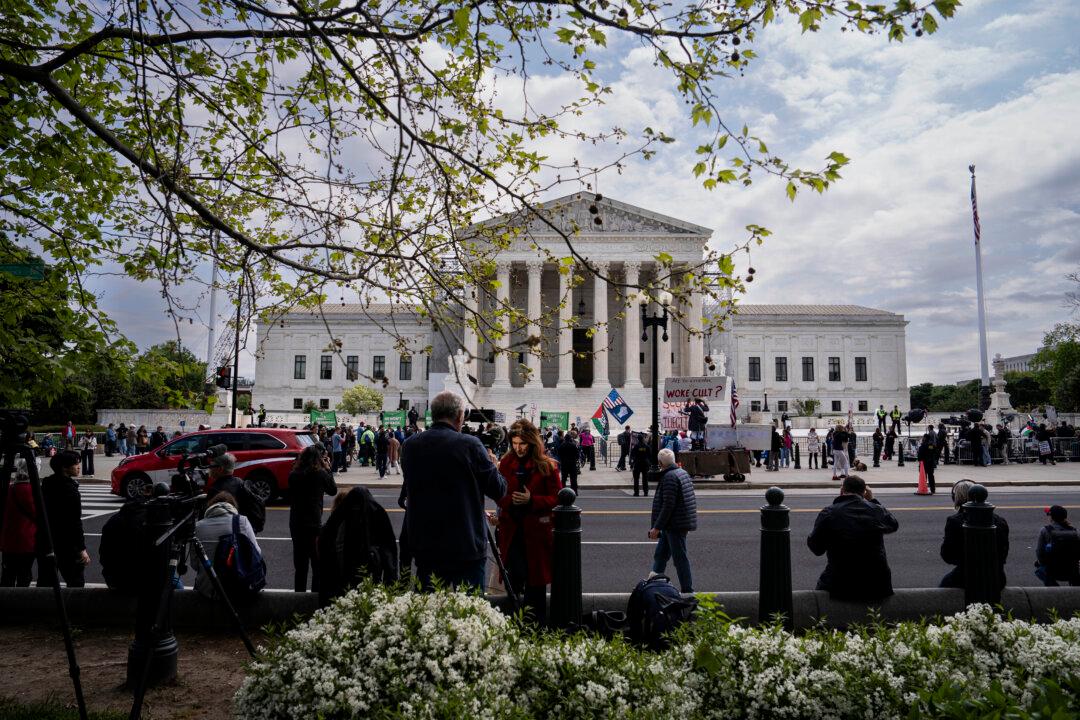An H1N1 survey done last month in Guangzhou, the capital of Southeastern China’s Guangdong Province, by an overseas Web site (h1n1china.org), indicates that the Chinese government greatly understated the number of deaths.
Earlier, Dr. Zhong Nanshan, an academician of Chinese Academy of Engineering and an expert in respiratory diseases, openly accused Chinese authorities of intentionally underreporting the pandemic. He stated that he “did not believe that there were only 53 H1N1 deaths in November [2009] announced by the government.” Chinese authorities have not provided any basis for this number of flu deaths.
The Web site conducted a random telephone survey in Guangzhou from Dec. 10 to 16, and surveyed 402 people, and about 26 percent of those were diagnosed with the flu in the past month.
Guangzhou had a population of 15 million by the end of 2009. At this rate, about 3.9 million residents in Guangzhou have the flu. H1N1 cases accounted for 100 percent of flu cases in November 2009, according to the announcement of the Guangzhou Bureau of Public Health on Dec. 5.
Last year, the Department of Health of Guangdong Province predicted that at the peak season of H1N1 pandemic, about 18 million people in Guangdong Province, 15 to 20 percent of its population, could be infected with H1N1.
Dr. Zhong pointed out that some academicians of Chinese Academy of Engineering have also predicted that about 10 to 20 percent of the population of China, 130 to 260 million people, could be infected with H1N1 influenza at its peak season.
The H1N1 infection rate from the survey seemed to match the expert predictions.
The survey concluded that the actual number of deaths may be at least 10 times higher than that announced by the Chinese Government.
Marc Lipsitich, professor of epidemiology at the Harvard School of Public Health, estimated that the death rate from the pandemic H1N1 flu is about 0.007 percent to 0.045 percent. The U.S. government announced in Dec 2009 that the H1N1 death rate was 0.02 percent.
Li Lianda, academician of Chinese Academy of Engineering, said that the death rate for H1N1 flu might be 0.065 percent in China, at The First Cross-Taiwan Strait Conference held in Beijing on Nov. 14 and 15.
The death tolls would be 273 to 1755 or 2535 based on Marc Lipsitch and Li Lianda’s prediction. An expert said that the death toll might be higher considering the large population and poor medical conditions in China.
However, as of Dec. 13, the Chinese government reported 25 H1N1 death cases in Guangdong.
Beijing has not announced H1N1 incidence rates and death rates.
The incidence and death rates for H1N1 flu in China are still unknown since the outbreak of H1N1 influenza.
On Dec. 1, Liang Wannian, director of the Office of Health Emergency, said that as of Nov. 29, the confirmed number of death was 178 cases nationwide. On Jan. 3, the Ministry of Health reported there were 648 H1N1 deaths by the end of 2009.
As of the end of November 2009, an estimated 80 million people in the United States had contracted the H1N1 virus, resulting in about 300,000 hospitalizations and 16,000 death cases, according to the U.S. Centers for Disease Control and Prevention.
How could the United States have a much higher H1N1 death rate than China does since the United States has a better diagnostic and medical treatment system? Some Chinese experts tried to explain that Chinese medicine had played an important role in preventing H1N1 flu from spreading.
Dr. Hu Zongyi, a virology expert in the National Institutes of Health (NIH), disagreed with the explanation. He pointed out that there is a lack of systematic research and evaluation of Chinese medicine being effective in preventing and curing H1N1 influenza. Moreover, very few cases of Chinese medicine’s curing H1N1 patients were reported in China.
Dr. Lin Xiaoxu is an expert in virology. Lin pointed out that H1N1 virus mutates easily. The virus has eight DNA segments instead of one and has a high probability of recombination with other virus in the host.
Dr. Zhong said that the H1N1 virus may mutate or recombine with H5N1 virus, and the new strain will cause a much greater infection rate and death rate. Thus, it is critical to monitor the death rate worldwide in order to find out whether the virus has mutated. This requires high transparency and honesty in H1N1 death-rate monitoring and reporting.
Read the Original Chinese Article: h1n1china.org/gb/10/1/16/n2789175.htm
Earlier, Dr. Zhong Nanshan, an academician of Chinese Academy of Engineering and an expert in respiratory diseases, openly accused Chinese authorities of intentionally underreporting the pandemic. He stated that he “did not believe that there were only 53 H1N1 deaths in November [2009] announced by the government.” Chinese authorities have not provided any basis for this number of flu deaths.
Twenty Percent of Surveyed Population Has Contracted H1N1
The Web site conducted a random telephone survey in Guangzhou from Dec. 10 to 16, and surveyed 402 people, and about 26 percent of those were diagnosed with the flu in the past month.
Guangzhou had a population of 15 million by the end of 2009. At this rate, about 3.9 million residents in Guangzhou have the flu. H1N1 cases accounted for 100 percent of flu cases in November 2009, according to the announcement of the Guangzhou Bureau of Public Health on Dec. 5.
Last year, the Department of Health of Guangdong Province predicted that at the peak season of H1N1 pandemic, about 18 million people in Guangdong Province, 15 to 20 percent of its population, could be infected with H1N1.
Dr. Zhong pointed out that some academicians of Chinese Academy of Engineering have also predicted that about 10 to 20 percent of the population of China, 130 to 260 million people, could be infected with H1N1 influenza at its peak season.
The H1N1 infection rate from the survey seemed to match the expert predictions.
Chinese Government Understated the Number of Deaths
The survey concluded that the actual number of deaths may be at least 10 times higher than that announced by the Chinese Government.
Marc Lipsitich, professor of epidemiology at the Harvard School of Public Health, estimated that the death rate from the pandemic H1N1 flu is about 0.007 percent to 0.045 percent. The U.S. government announced in Dec 2009 that the H1N1 death rate was 0.02 percent.
Li Lianda, academician of Chinese Academy of Engineering, said that the death rate for H1N1 flu might be 0.065 percent in China, at The First Cross-Taiwan Strait Conference held in Beijing on Nov. 14 and 15.
The death tolls would be 273 to 1755 or 2535 based on Marc Lipsitch and Li Lianda’s prediction. An expert said that the death toll might be higher considering the large population and poor medical conditions in China.
However, as of Dec. 13, the Chinese government reported 25 H1N1 death cases in Guangdong.
Beijing has not announced H1N1 incidence rates and death rates.
The incidence and death rates for H1N1 flu in China are still unknown since the outbreak of H1N1 influenza.
On Dec. 1, Liang Wannian, director of the Office of Health Emergency, said that as of Nov. 29, the confirmed number of death was 178 cases nationwide. On Jan. 3, the Ministry of Health reported there were 648 H1N1 deaths by the end of 2009.
As of the end of November 2009, an estimated 80 million people in the United States had contracted the H1N1 virus, resulting in about 300,000 hospitalizations and 16,000 death cases, according to the U.S. Centers for Disease Control and Prevention.
How could the United States have a much higher H1N1 death rate than China does since the United States has a better diagnostic and medical treatment system? Some Chinese experts tried to explain that Chinese medicine had played an important role in preventing H1N1 flu from spreading.
Dr. Hu Zongyi, a virology expert in the National Institutes of Health (NIH), disagreed with the explanation. He pointed out that there is a lack of systematic research and evaluation of Chinese medicine being effective in preventing and curing H1N1 influenza. Moreover, very few cases of Chinese medicine’s curing H1N1 patients were reported in China.
Death Rate Is Extremely Important
Dr. Lin Xiaoxu is an expert in virology. Lin pointed out that H1N1 virus mutates easily. The virus has eight DNA segments instead of one and has a high probability of recombination with other virus in the host.
Dr. Zhong said that the H1N1 virus may mutate or recombine with H5N1 virus, and the new strain will cause a much greater infection rate and death rate. Thus, it is critical to monitor the death rate worldwide in order to find out whether the virus has mutated. This requires high transparency and honesty in H1N1 death-rate monitoring and reporting.
Read the Original Chinese Article: h1n1china.org/gb/10/1/16/n2789175.htm



